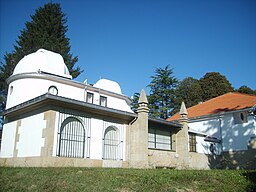Ramón María Aller Ulloa
Ramón María Aller Ulloa (Lalín, February 3, 1878 - March 28, 1966) was a Spanish astronomer, mathematician and Catholic priest. Professor at the University of Santiago de Compostela, he carried out several relevant astronomical studies and observations, developing instruments that were adopted by other centers, such as the Paris Observatory. He was a polyglot and mastered ten languages.
Biography
Ramón Aller was born on February 3, 1878 in the Filgueiroa manor in Donramiro, Lalín, province of Pontevedra, Galicia (Spain). He was the son of the Lalín notary, Domingo Enrique Aller Rodríguez.
He began studying with the Jesuits in La Guardia and continued them at the seminary in Lugo. At the age of twenty he obtained a doctorate in theology. He was ordained a priest with a two-year dispensation.
He fell ill in 1964 and moved to his hometown where he died on March 28, 1966, at the age of eighty-eight.
Professional career
In 1899 he began, on his own at the University of Oviedo, the studies of Exact Sciences that he would continue at the University of Madrid, reaching his bachelor's degree in 1904 at the age of 26. In 1912 he received his doctorate with an extraordinary award and, in this same year, he built the first astronomical observatory in Galicia in Lalín.
He began his hobby of astronomical observation with a 75 mm aperture telescope that his grandmother Camila Ulloa had given him when he was a seminarian. To this first instrument he added a theodolite that María Lajosa Sánchez gave him. These were the first instruments that he assembled in the observatory that he installed in the gallery of his house. With them, and some other auxiliary instrument such as a Navy chronometer, he made the first systematic observations of the cosmos that were collected in the Yearbook of the Madrid Observatory. He then carried out a series of observations along with theoretical studies that were published in the Magazine of the Astronomical Society of Spain and America .

In 1918 he edited the mathematics book Algorithmia which was sponsored by his uncle Saturnino Aller. When this Ramón dies, he keeps his property in usufruct and decides to increase the observation instruments by acquiring a 120 mm refractor with a focal length of 1,800 mm. The installation of this instrument, which would be launched in 1925, required the modification of his observatory to which he had to add a dome. To start up the refractor he carries out a meticulous program to follow (this program is published in Archive of the Seminario de Estudios Gallegos in 1932 under the title Lalín Observatory Program).
The first point of the program was the observation of double stars. The results of these observations were published in the German magazine Astronomiche Narichtench, Europe's main astronomy magazine. These studies were pioneers in Spain and created an important school at the University of Santiago.
From 1930 he published his first works in the magazine Astronomiche Narichtench until 1939 he edited more than 40 works in different national and foreign media. He also completed an interesting treatise on astronomy that he had been writing since his youth. He completed these observational works, relevant and extraordinary considering the limited resources, with the preparation of plans, teaching and even the biography of José Rodríguez González, the Bermés Mathematician .
In 1939, he was in charge of explaining analytical geometry and mathematical analysis at the University of Santiago de Compostela. In 1943 an observatory was built at the University of Santiago where Lalín's instruments were transferred and in 1944 the Chair of Astronomy was created for him.
On June 30, 1943, he presented his doctoral thesis at the University of Madrid with the topic Some experiences that should be carried out in the observations of vertical steps and that same year he was appointed Director of the Astronomical Observatory and edits Introduction to Astronomy, a work that he had been preparing since his youth. He expanded the observatory with a step telescope provided by the Higher Council for Scientific Research.

In 1945 he created the Theoretical Astronomy and Mathematics section Durán Loriga, the seed of what would later become the Faculty of Mathematics. During the 40s and 50s the observatory was at full capacity, publishing these works in publications of the Santiago observatory. At that time is also when the chair of astronomy directed by Aller was created until 1949 when he was named Extraordinary Professor of Astronomy. In 1948 he was appointed member of Commission 26 of the International Astronomical Union of Zurich and published the book Astronomy at a glance . The following year, in 1949, he was appointed member of the National Astronomy Commission. Between 1960 and 1963 he directed three doctoral theses.
Recognitions
His work includes more than seventy-eight articles published in different media, four books, five doctoral theses directed by him, four discovered stars and numerous plans and designs of observation and measurement instruments as well as many other materials on different topics.
Ramón María Aller was a member of the Academy of Exact Sciences of Madrid, the Astronomy Commission and other world institutions. He invented measuring and observation apparatus, some of which were adopted by the Paris observatory. He was named professor and life director of the Santiago observatory, honorary coengo, and adopted son of the city of Santiago de Compostela. Astronomers Hugh Percy Wilkins and Patrick Moore named a crater on the Moon Aller, although the crater was later renamed in honor of the English mathematician George Atwood.[citation needed]
The Astronomical Observatory of the University of Santiago de Compostela bears his name.
Aurora borealis
In 1938 he was able to observe the northern lights from Lalín.
Decorations
- Grand Cross of the Civil Order of Alfonso X el Sabio (1955)
Contenido relacionado
Period
(464) Megaira
Subtraction